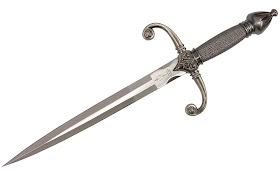Antonio del Pollaiolo (b.1429/1433, d. 1498) was an Italian painter, sculptor, engraver and goldsmith during the Renaissance, renowned for his understanding of anatomy. He created a remarkable bas-relief panel of a knife fight involving twelve participants, of which below is a line drawing taken from Italian Sculpture of the Middle Ages and Period of the Revival of Art (1862), by John Charles Robinson.
Antonio Pollaiuolo, Relievo, in Terra-cotta; "A Combat of Nude Figures." Length 1 foot 10 inches, height 1 foot 4 inches. (Gigli-Campana Collection.)
One of the pairs of fighters is holding a length of chain, in the manner of the duelists holding a sash in the bowie-knife duel in The Long Riders. Another pair has shields but are also connected by a chain; whether they are holding it or are shackled to it is not clear. Robinson gives this description of the scene:
In front of the composition, towards the right, the principal group is of two young warriors fighting with daggers, and protecting themselves with oval or kite-shaped shields; in the lower corner, on the same side, a more aged bearded man is slaying a prostrate foe: and on the left, also in the principal plane of the composition, another man is killing his vanquished enemy, whom he grasps by the hair. In the upper part of the composition, represented as in a second or more distant plane, and consequently in somewhat lower relief, are three other groups, as follow, viz. :—On the right, two men grasping a chain with their left hands, whilst they fight with daggers held in their right; in the centre, a combatant is striking his wounded enemy, who is forced with one knee on the ground, and is endeavouring to ward oft the blow with his shield; and on the extreme left a man is tying his prisoner to a tree in the attitude of a Marsyas or St. Sebastian. The weapon used is the stiletto or pugnale in use at the period in Italy; and the group who are holding the chain are evidently fighting a duel, in a method probably sanctioned by contemporary usage; each combatant grasps one end of the chain firmly with his left hand, the two keeping it strained horizontally betwixt them, so that it obviously serves as a means of parrying the blows,—a method of defence evidently mutually agreed upon by the combatants.Robinson uses the Italian word pugnale for the dagger. In Latin it would be known as the pugio, the dagger the Roman soldier wore at his left side as a last-ditch weapon, or when in such close combat that even his gladius was too long. It derives from the Latin pugio, pugnus, the fist.
Below is another fight scene by Pollaiolo, this time showing the use of the sword. Double click on the image for a larger version.


For myself, I’d take it off the cheap knives and put it in you carry-on bag and nothing will probably be said about it.
ReplyDelete